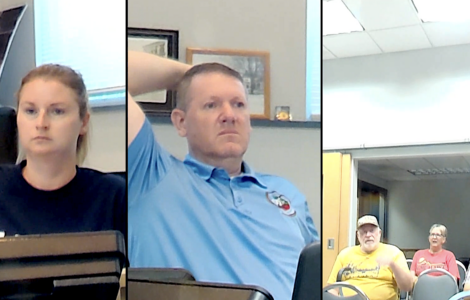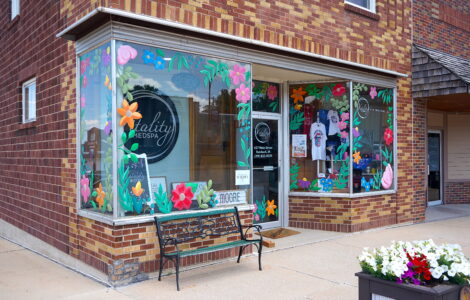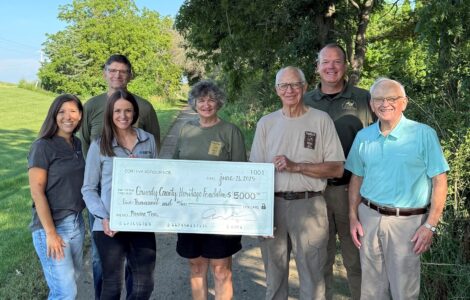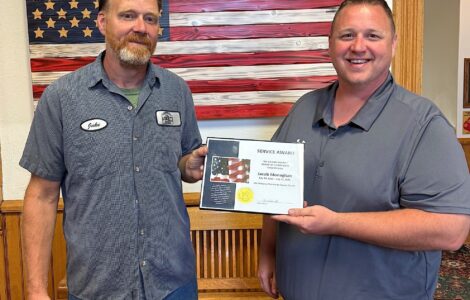G-R’s second bond vote meeting stokes emotion
Meeting held at Gladbrook Memorial Building

More than 125 people attended the G-R bond vote community meeting held at the Gladbrook Memorial Building on Wednesday, August 24. Once seating was filled in the main room (pictured), chairs were set up in the entrance area. PHOTO BY RUBY F. MCALLISTER
One of the most popular places to be in Gladbrook last Wednesday, Aug. 24 appeared to be the G-R bond referendum community meeting held at the Memorial Building as more than 125 people came out for the event.
It was the second of three meetings the Gladbrook-Reinbeck Community School District plans to hold in the weeks leading up to the Tuesday, Sept. 13 special school bond election that, if passed, would provide the district up to $23.6 million in additional revenue to address facility upgrades and space needs.
Superintendent Erik Smith opened the meeting by welcoming those in attendance and providing a brief framework for the evening.
In addition to Smith, other speakers included G-R school board president Donovan Devore, Andrew Bell with Align Architecture, Dan Keagle, the district’s construction manager, and Matthew Gillaspie with the financial firm Piper Sandler.
Smith told the audience those with questions that went unanswered by the meeting’s end could either contact him directly at the school or use the district’s dedicated bond vote website which features fact sheets and a lengthy Q&A page. The website can be accessed here: https://www.grcsdplanning.org

Members of the Gladbrook community listen during the G-R bond vote public meeting held at the Memorial Building on Aug. 24. PHOTO BY RUBY F. MCALLISTER
Following Smith’s introductory remarks, Devore took the podium and after briefly summarizing the facility study work the district has undertaken over the last few years he then addressed the topic which had – in all likelihood – brought out a good number of the more than 100 people in attendance and it wasn’t the details behind the need for HVAC upgrades or an elevator or handicap accessibility or safety and security – nor was it the property tax impact.
Instead, Donovan publicly addressed the schism that has arisen between the communities of Gladbrook and Reinbeck over the past decade since the decision was made to close the Gladbrook school and ultimately tear it down.
A schism that has led dozens and dozens of G-R parents – many with Gladbrook addresses – to open enroll their children in nearby districts, primarily the GMG district.
“Our district has a 34-year history together. It is marred by various events,” Devore said. “This has caused disruption for both communities. But then we need to bring it back to what our focus should be – our kids. And now we’re standing at a crossroads of do we proceed forward, charge ahead as Rebels together or do we dwell in the past and maintain the status quo.”
Devore then addressed several recurring comments he has read on social media opposed to one aspect or another of the district’s plans to upgrade its facilities by using his own children at times as examples of why such upgrades are necessary.

G-R elementary principal Shaun Lehmann answers an audience member’s question during the bond vote community meeting held in Gladbrook on Aug. 24. PHOTO BY RUBY F. MCALLISTER
He then ended his remarks by refocusing on the G-R student body.
“So what I’m not going to accept is that this referendum is not about the kids,” Devore said before thanking the audience again for attending and introducing architect Andrew Bell.
Bell’s presentation on the district’s facility needs was a streamlined version of the one he gave during the first community meeting held in Reinbeck on July 26. Sun Courier reporting from that meeting can be accessed here.
Bell again highlighted that a “do-nothing solution” would still amount to almost $10 million in maintenance and ADA compatibility upgrades.
Keagle with Peters Construction spoke as well, highlighting the cost analysis he had completed as the district’s construction manager. Keagle’s comments were also similar to those provided during the July 26 meeting.

A member of the audience waits to ask a question of members of the G-R school district during the bond vote community meeting held on Aug. 24 at the Gladbrook Memorial Building. PHOTO BY RUBY F. MCALLISTER
The school district’s financial advisor Matthew Gillaspie was the final scheduled speaker of the evening before the floor was opened to questions. Gillaspie addressed specifically the effect the referendum could have on property taxes.
But before Gillaspie could begin his formal presentation a member of the audience interjected, firmly putting into words what was becoming increasingly apparent just by looking at many of the audience members’ body language and facial expressions: “We’re not interested in that; we’ve got other questions.” The audience was assured by Devore that questions would be answered following the financial presentation.
Gillaspie’s lengthy presentation can be viewed in full on the district’s bond vote website, accessible here: https://www.grcsdplanning.org
- More than 125 people attended the G-R bond vote community meeting held at the Gladbrook Memorial Building on Wednesday, August 24. Once seating was filled in the main room (pictured), chairs were set up in the entrance area. PHOTO BY RUBY F. MCALLISTER
- G-R elementary principal Shaun Lehmann answers an audience member’s question during the bond vote community meeting held in Gladbrook on Aug. 24. PHOTO BY RUBY F. MCALLISTER
- G-R school board member Rod Brockett (left) listens as an audience member asks him a question regarding decisions that were made in 2015 versus today by the board and the district surrounding the closure of the Gladbrook school. Board president Donovan Devore listens beside him. PHOTO BY RUBY F. MCALLISTER
- A Gladbrook resident asks a question of school board member Rod Brockett (not pictured) during the G-R school vote community meeting held at the Gladbrook Memorial Building on Aug. 24. PHOTO BY RUBY F. MCALLISTER
- A member of the audience waits to ask a question of members of the G-R school district during the bond vote community meeting held on Aug. 24 at the Gladbrook Memorial Building. PHOTO BY RUBY F. MCALLISTER
- Members of the Gladbrook community listen during the G-R bond vote public meeting held at the Memorial Building on Aug. 24. PHOTO BY RUBY F. MCALLISTER
The meeting’s handout included a graphic that used a hypothetical home in the G-R district (assessed at $100,000) to show how the tax impact could be calculated. After factoring in the 56.41 percent state rollback, the taxable value of such a home would be $56,409. After subtracting the Homestead Credit ($4,850), the net taxable value would be $51,559. The handout then multiplies the net taxable value by the levy rate increase, equating to a $199.69 increase in taxes per year (or $16.63 per month) per $100,000 of assessed home value.
If the bond passes on Sept. 13, Gillaspie said January 2022 property values would be used.

G-R school board member Rod Brockett (left) listens as an audience member asks him a question regarding decisions that were made in 2015 versus today by the board and the district surrounding the closure of the Gladbrook school. Board president Donovan Devore listens beside him. PHOTO BY RUBY F. MCALLISTER
Gillaspie also gave an example of what the “average” ag land owner would pay using 320 acres as the basis. Such a property owner would be expected to pay about $2100 per year in additional taxes to generate the bond amount, he said.
The ballot
There will be two ballot questions put to voters within the G-R district boundaries on September 13.
The first question addresses the overall price tag by asking voters to approve the district taking on general obligation bond debt not to exceed $23,605,000 to be used in conjunction with SAVE (sales tax) revenue bonds already approved by the school board to “build, furnish, and equip additions to and to remodel, repair, improve, furnish, and equip District facilities, including related site improvements.”
The second question addresses property taxes – which would fund the purchase of the bonds in the first question – and asks voters to approve an annual levy exceeding $2.70 per $1000 of the assessed value of the taxable property but not exceeding $4.05 per $1000.

A Gladbrook resident asks a question of school board member Rod Brockett (not pictured) during the G-R school vote community meeting held at the Gladbrook Memorial Building on Aug. 24. PHOTO BY RUBY F. MCALLISTER
Both questions need a super majority – at least 60 percent – to pass. The first question does not require the second question to pass in order to be implemented, but if the second question passes and the first fails, the matter would have to be put to voters again in a subsequent election – if the district chooses to do so.
By approving only the first question, voters are essentially agreeing to bond up to roughly $23.6 million but limiting the manner in which the district can do so to only $2.70 per $1000 of assessed value of the taxable property. Limiting the levy power of the district in this way would allow for some of the $23.6 million to be bonded for and used – but nowhere near the total amount.
During the Q&A that followed Gillaspie’s presentation, several questions touched on the district focusing on maintenance and ADA compatibility only. Passing the first ballot question only would more than likely allow for those needs to be addressed based on financial data.
As it stands, G-R currently has the 29th lowest tax rate in the state of Iowa, according to Gillaspie.
Q&A
The opportunity to ask questions of superintendent Smith, school board president Devore, and others with the district was clearly what the majority of those in the room had been waiting for – with many having clearly been waiting for years.
Enrollment numbers including enrollment out of district was a repeated question as was why the need to expand classroom space at the elementary school.
As reported in an earlier story by the Sun Courier, open enrollment out of the G-R district has been increasing since the 2014-2015 school year with much of that increase attributed to the closing of the Gladbrook school.
The district’s bond vote website now lists enrollment numbers with the following caveat: “Last school year, 165 students open-enrolled out of GR, an increase from the 70 that did so in 2015-16. This means the district loses approximately an additional $900,000 per year in revenue. This is significant, but not nearly enough to address the district’s facility needs.”
At one point during the Q&A, elementary principal Shaun Lehmann was asked to address an audience member’s question about the district’s full-day Transitional Kindergarten (TK) program which has been part of the driving need for space.
One of the reasons the district went to full-day T-K, Lehmann shared, was to give Gladbrook students who travel an extensive distance – it’s roughly 17 miles between the two communities – a full day of learning complete with breakfast and lunch.
“I don’t care if you live two minutes away or 20 minutes away, we want to do everything we can to support every kid,” Lehmann said.
Lehmann also shared that this school year 20 percent of the G-R kindergarten class (including TK) has Gladbrook addresses – the most that percentage has been since the school closed in Gladbrook.
Another audience question pertained to how the district is accommodating students with disabilities now if the buildings are not ADA-accessible. Smith said thankfully the elementary school is all on one level and as such is the district’s most accessible building.
“We’ve been lucky,” Smith admitted. “But we know it’s coming. … We need to make that [aspect] better for all our students moving forward.”
Many of the questions went beyond the basics of the bond vote, however, and were emotionally charged.
“If we were all G-R,” an audience member asked at one point from the entrance area just beyond the packed room, “then why was our school torn down?”
A poignant moment came when an individual asked for a school board member who served in 2015 when the Gladbrook school was closed to answer his question to which board member Rod Brockett took the microphone.
The questioner wanted to know “what has changed” from 2015 when the decision was made to close the school due to declining enrollment and financial reasons, to today.
“Back in 2015,” Brockett began, “we were coming off of at least 15 years of declining enrollment. Starting in 2017 – four out of the last five years – we’ve had increasing enrollment. … Because of declining enrollment over those years, we’ve had to make cuts to staff without trying to impact too many programs that we did offer. And so, at that point in time [2015] – because all of the information we had was declining enrollment – that’s where we were anticipating our future would go. And because of that, we were looking at needing to cut costs. And one major way to cut costs was to close a building.”
A low hum of murmurs and sighs could be heard coming from the audience at this point in Brockett’s answer.
“Since that time, we’ve had increasing enrollment. Our financial situation has greatly improved,” Brockett continued in a steady, calm manner. “And personally, not as a school board member but just as a citizen of this school district, up until this point, I would not have been in favor of any kind of bond – not nearly of this size – because I was not confident that this school district would be here for the future.”
“At this point, because of where our financials are at, I am confident that we will be here for the foreseeable future. For the next 15-20 years and I didn’t have that confidence back in 2015.”
An individual from Gladbrook then stood up and said he would like to make a statement.
“There’s no connection anymore,” the individual said in part. “The connection now is with GMG. … Why after seven years are you suddenly interested in us?”
Many in the audience responded by calling out, “Money,” which elicited healthy applause.
“I can’t sit here and say I understand what anyone’s feeling,” Supt. Smith answered while standing at the front of the room facing the audience, many of whom had their arms crossed and were looking down. “But we are both legally on paper … and as a group, we are still the Gladbrook-Reinbeck School District. And so we did feel it was important … to come down knowing there would be some upset people. Knowing there would be some challenging questions but we felt it was necessary for us to come down here and answer these questions.”
“But we’ve moved on,” the original questioner simply responded.
Third and final meeting
Shortly after the exchange between the superintendent and the audience member – following a few more questions and audience statements – the meeting was wrapped up due to time.
The third and final community meeting is set for Wednesday, September 7 beginning at 6:30 p.m. in the Gladbrook-Reinbeck High School Gym. The Sun Courier will provide full coverage of the final meeting.
The bond question will appear on a special election ballot Tuesday, September 13.




